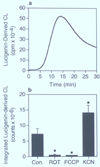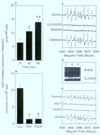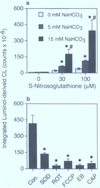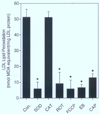Mitochondrial Electron Transport Chain-Derived Superoxide Exits Macrophages: Implications for Mononuclear Cell-Mediated Pathophysiological Processes
- PMID: 28133629
- PMCID: PMC5268359
- DOI: 10.20455/ros.2016.815
Mitochondrial Electron Transport Chain-Derived Superoxide Exits Macrophages: Implications for Mononuclear Cell-Mediated Pathophysiological Processes
Abstract
The involvement of mitochondrial electron transport chain (METC)-derived superoxide anion radical in cell protooncogene activation, mitogenic responses, and cancerous growth has recently received much attention. In order for METC-derived superoxide to participate in any of the above processes, its exit from mitochondria would be a critical step. Detection of intracellular superoxide showed that mitochondrial respiration is the major source of cellular superoxide in unstimulated or resting monocytes/macrophages. However, direct evidence for the exit of superoxide from mitochondria is presently lacking. Here we show that METC-derived superoxide does exit from mitochondria in unstimulated monocytes/macrophages. Release of superoxide was first found to occur with substrate-supported mitochondria isolated from these cells. We also observed the presence of extracellular superoxide with the intact unstimulated/resting cells. Extracellular superoxide was markedly diminished (>90%) by the mitochondrial inhibitor, rotenone, or the uncoupler, carbonylcyanide p-(trifluromethy) phenylhydrazone. Furthermore, cells with a deficient METC exhibited significant reduction (>90%) in extracellular superoxide, demonstrating that with intact cells METC-derived superoxide not only exits from mitochondria, but can be released extracellularly. Superoxide anion radical released from mitochondria could react with exogenous nitric oxide, forming peroxynitrite. Mitochondria-derived extracellular superoxide could also oxidize low-density lipoprotein (LDL). These results thus resolve any uncertainty on the ability of superoxide to exit from mitochondria. This study for the first time also identifies mitochondria as the major source of extracellular superoxide in unstimulated resting monocytes/macrophages, which has implications for the involvement of these mononuclear cells in various pathophysiological situations.
Keywords: Chemiluminescence; Electron paramagnetic resonance; Low-density lipoprotein; Macrophages; Mitochondrial electron transport chain; Monocytes; Mononuclear cells; Peroxynitrite; Reactive oxygen species; Superoxide.
Figures








Similar articles
-
Nanoceria potently reduce superoxide fluxes from mitochondrial electron transport chain and plasma membrane NADPH oxidase in human macrophages.Mol Cell Biochem. 2021 Dec;476(12):4461-4470. doi: 10.1007/s11010-021-04246-7. Epub 2021 Sep 3. Mol Cell Biochem. 2021. PMID: 34478033 Free PMC article.
-
Diphenyleneiodonium, an NAD(P)H oxidase inhibitor, also potently inhibits mitochondrial reactive oxygen species production.Biochem Biophys Res Commun. 1998 Dec 18;253(2):295-9. doi: 10.1006/bbrc.1998.9729. Biochem Biophys Res Commun. 1998. PMID: 9878531
-
Detection of mitochondria-derived reactive oxygen species production by the chemilumigenic probes lucigenin and luminol.Biochim Biophys Acta. 1999 Jun 28;1428(1):1-12. doi: 10.1016/s0304-4165(99)00040-9. Biochim Biophys Acta. 1999. PMID: 10366754
-
Nitric oxide and peroxynitrite interactions with mitochondria.Biol Chem. 2002 Mar-Apr;383(3-4):401-9. doi: 10.1515/BC.2002.044. Biol Chem. 2002. PMID: 12033431 Review.
-
Reactive oxygen species and nitric oxide in plant mitochondria: origin and redundant regulatory systems.Physiol Plant. 2010 Apr;138(4):447-62. doi: 10.1111/j.1399-3054.2009.01340.x. Epub 2009 Dec 9. Physiol Plant. 2010. PMID: 20059731 Review.
Cited by
-
Graphene Quantum Dots Protect against Copper Redox-Mediated Free Radical Generation and Cardiac Cell Injury.React Oxyg Species (Apex). 2018 Sep;6(17):338-348. doi: 10.20455/ros.2018.855. React Oxyg Species (Apex). 2018. PMID: 30177973 Free PMC article.
-
Uncovering the Role of Oxidative Imbalance in the Development and Progression of Bronchial Asthma.Oxid Med Cell Longev. 2021 Mar 3;2021:6692110. doi: 10.1155/2021/6692110. eCollection 2021. Oxid Med Cell Longev. 2021. PMID: 33763174 Free PMC article. Review.
-
Detection of Superoxide Alterations Induced by 5-Fluorouracil on HeLa Cells with a Cell-Based Biosensor.Biosensors (Basel). 2019 Oct 16;9(4):126. doi: 10.3390/bios9040126. Biosensors (Basel). 2019. PMID: 31623083 Free PMC article.
-
Negative Impacts of Arsenic on Plants and Mitigation Strategies.Plants (Basel). 2023 Apr 28;12(9):1815. doi: 10.3390/plants12091815. Plants (Basel). 2023. PMID: 37176873 Free PMC article. Review.
-
Multi-Protection of DL0410 in Ameliorating Cognitive Defects in D-Galactose Induced Aging Mice.Front Aging Neurosci. 2017 Dec 8;9:409. doi: 10.3389/fnagi.2017.00409. eCollection 2017. Front Aging Neurosci. 2017. PMID: 29276489 Free PMC article.
References
-
- Miles PR, Lee P, Trush MA, Van Dyke K. Chemiluminescence associated with phagocytosis of foreign particles in rabbit alveolar macrophages. Life Sci. 1977;20(1):165–170. - PubMed
-
- Fang FC. Antimicrobial reactive oxygen and nitrogen species: concepts and controversies. Nat Rev Microbiol. 2004;2(10):820–832. - PubMed
-
- Hansson GK. Inflammation, atherosclerosis, and coronary artery disease. N Engl J Med. 2005;352(16):1685–1695. - PubMed
Grants and funding
LinkOut - more resources
Full Text Sources
Other Literature Sources
